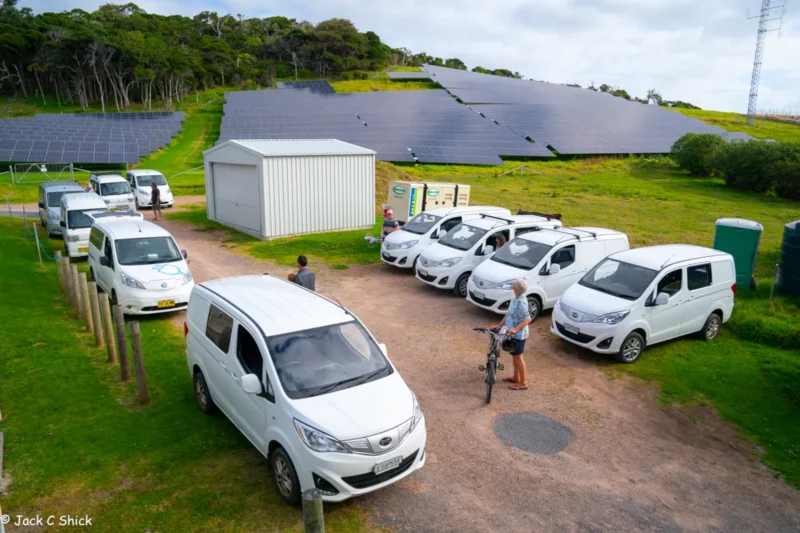Earlier this year I spent a week holidaying on Lord Howe Island, enjoying the beautiful scenery and unique birdlife on the island, as well as the amazing hikes and snorkelling spots that are just a short swim off the beaches.
The renewable energy system and electric vehicles I saw driving around also sparked my interest, so I was keen to learn more about them. While on the island I met Chris Murray at the museum, who helpfully answered my questions and later put me in touch with other island residents to understand their EV journeys.
Stuart Watson of Wauchope Solar & Electrical and the Greens candidate for the state seat of Port Macquarie, also played a key role in terms of solar power and electric transport on Lord Howe Island. He installed more than 20 solar systems on residents’ houses and helped many EV owners purchase and import their vehicles.
First EVs arrive in the 80s and 90s
I was amazed to learn that the first electric car to arrive on Lord Howe Island was all the way back in the early 1980s, when the LHI Board imported a converted Suzuki Carry Van as part of a renewable energy investigation by state owned Pacific Power. Being an early electric conversion, the carry van had some quirks and was returned to the mainland after just 6 months.
The next EV on the island landed in August 1995, which was an electric conversion of a Nissan Prairie van, that Chris and his colleagues used as Eastern Australian Airlines Agents on Lord Howe.
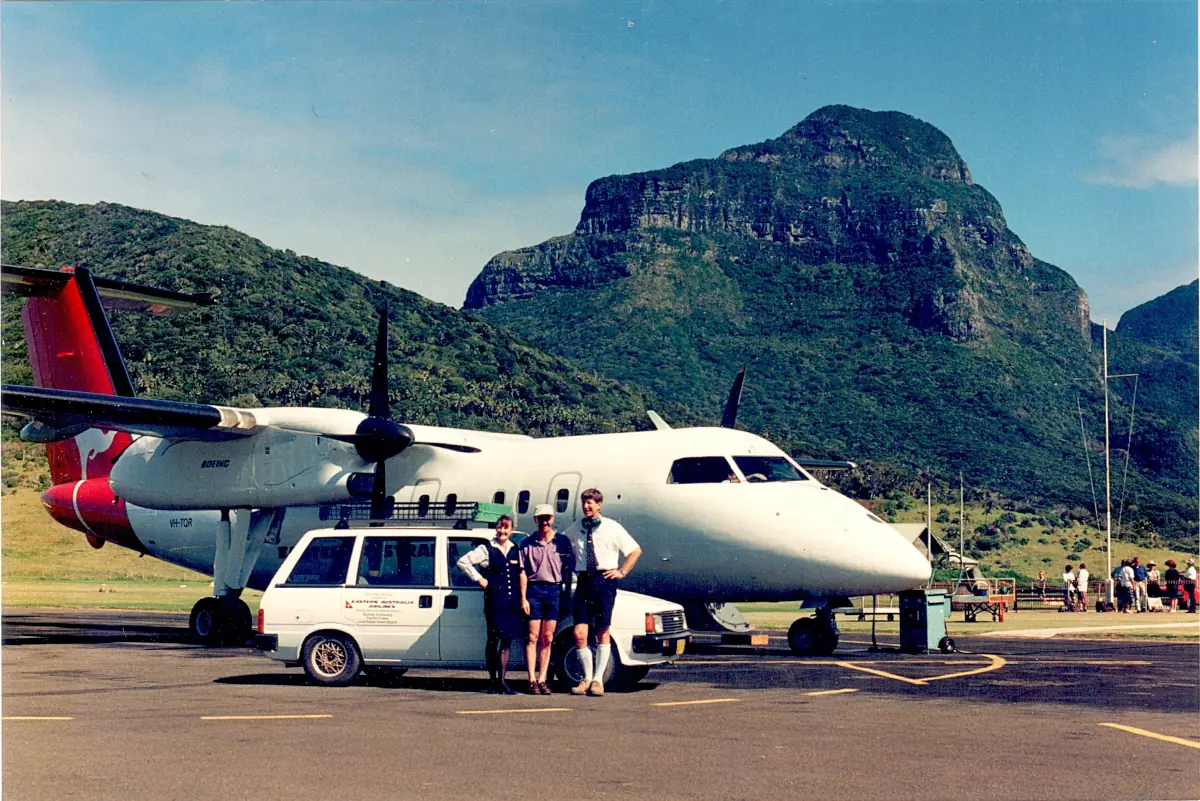
The idea for using electric vehicles to deliver freight on Lord Howe Island was kickstarted by David Gosden, Director of Electric Vehicle Research at Sydney University, who visited the island and met Chris while on holiday.
After a feasibility study, EAA agreed to fund the conversion which was performed by Les Puklowski of Huntington Enterprises. The purchase of a second hand Prairie and conversion came to a total cost of $26,000, similar to buying a new petrol van at the time.
The Nissan Prairie was kitted out with a 96 Volt electric motor and 16 deep cycle ALCO lead-acid batteries, which provided more than enough range to cover the 50 km per day that Chris typically needed for his deliveries. Running costs for the Prairie at the time were calculated at 4.74 c/km, much better than 14.28 c/km for a neighbour’s petrol Ford Laser.
Sometime after the Prairie arrived on Lord Howe, Chris’s interest in EVs led him to track down and purchase the original electric Suzuki Carry Van. The Suzuki was mainly used for private family transport, although it occasionally delivered freight for EAA when the Prairie was being serviced or repaired.
The Suzuki EV also ended up being involved in an unlikely controversy with Australia Post when it was temporarily used to deliver local “zemail” (zero emission mail) and freight between Island resident’s houses.
Australia Post does not deliver on Lord Howe but saw letter-box red when they found out the service used gummed labels like postage stamps to receipt local deliveries. The dispute was eventually resolved when the ACCC weighed in on the side of locals. Australia Post had to back down and local electric vehicle deliveries were allowed to continue uninterrupted.
However, both the Suzuki EV and Nissan Prairie eventually succumbed to rust from the salty sea air as well as maintenance issues that none of the local island mechanics knew how to fix, so they were sent back to the mainland in 2005.
To read more about the Nissan Prairie conversion see the Energy Focus article from July 1996, as featured on the 50th issue cover shown below.
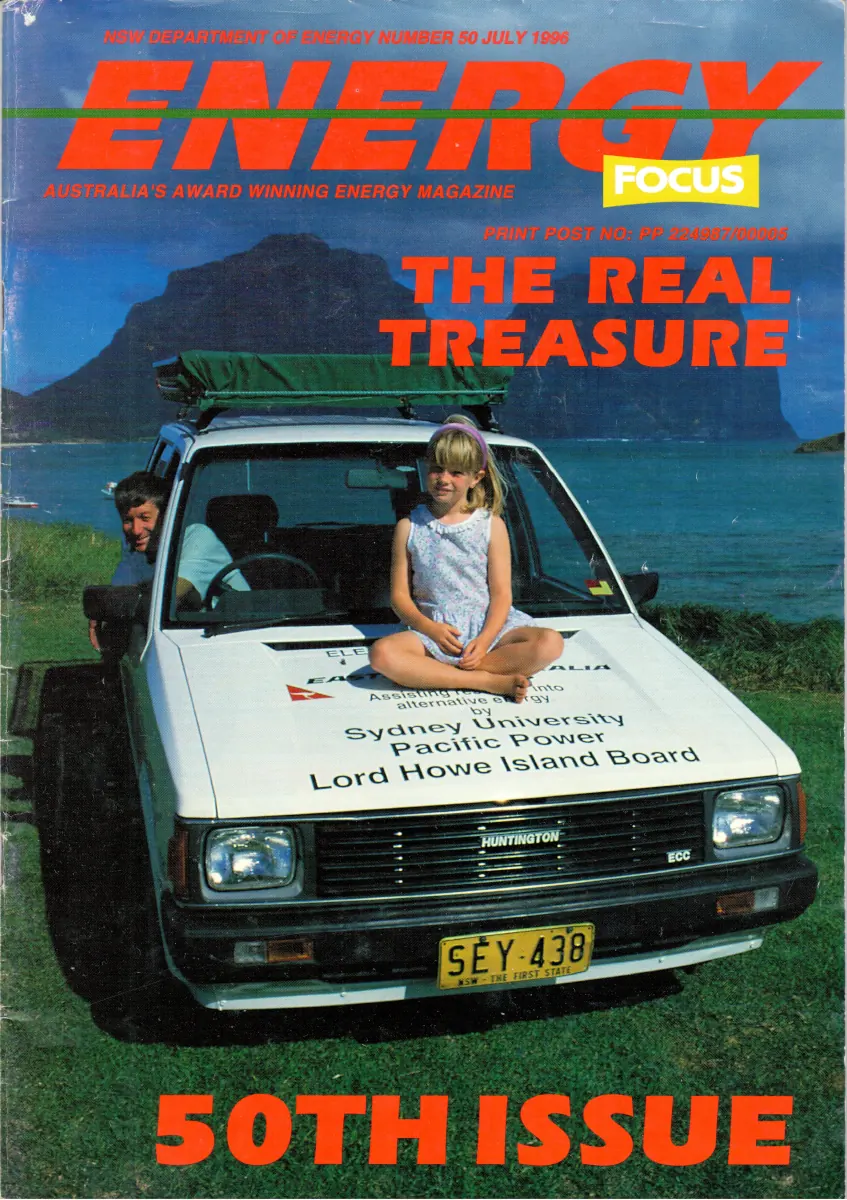
Powering up the island with renewables
Lord Howe Island seems like the ideal spot for renewable energy and electric vehicles. Situated 600 km east of Port Macquarie, shipping diesel and petrol to the island is expensive and polluting compared to harnessing the plentiful sunshine and wind resources that are available.
Unfortunately, initial plans to install a hybrid solar, wind and battery storage system on the island were blocked against departmental advice by Josh Frydenberg in 2017, environment minister at the time.
Thankfully, Australian Renewable Energy Agency (ARENA) funding was later secured in 2019 to proceed with a larger solar and battery storage system, minus the 2 wind turbines from the earlier plans.
The Hybrid Renewable Energy Project (HREP) was commissioned in 2021, consisting of a 1.3 MW solar farm and 3.7 MWh Tesla Powerpack battery system, joining the existing 3×300 kW diesel generators.

Paint may have faded on the outside of the Tesla battery in 4 years, but the latest report from ARENA published in 2024 states the system is going strong and outperforming expectations, with an average of 70% renewable energy penetration over the first 2 years of operation.
During the first 2 years, the renewable energy project saved over 700,000 L of diesel, which equates to around $1.55 million in savings. “The hybrid renewable energy project has improved Lord Howe’s self-sufficiency whilst also reducing the island’s reliance on diesel generators and imported fuels,” the report says.
Environmental benefits and low maintenance make EVs the obvious choice
There was a gap between the electric Nissan Prairie conversion retiring in 2005 and the first commercially built electric vans arriving on Lord Howe Island, but they have since proven popular and grown to number double digits in recent years. Most of them can be seen in the featured image at the start of this article.
The current count for the island is 15 electric vehicles in total – 5 BYD T3 vans, 4 Nissan e-NV200 vans, 4 Mitsubishi iMiEVs (3 configured as vans and 1 ute) and 2 golf carts owned by Capella Lodge. Stuart Watson lobbied for rule changes to allow the golf carts to be used on the road with a conditional registration.
The latest Lord Howe Island census data from 2021 has the total number of passenger and light commercial vehicles around 160, which we can assume has not changed much given the Lord Howe Island Board tightly controls vehicles on the island.
Using these figures, EV penetration is already above 9%, or 8% not counting the golf carts. Either way, the EV percentage is far higher than equivalent figures for the whole of Australia, with approximately 300,000 EVs representing only 1.5% of vehicles in a fleet of 20 million.
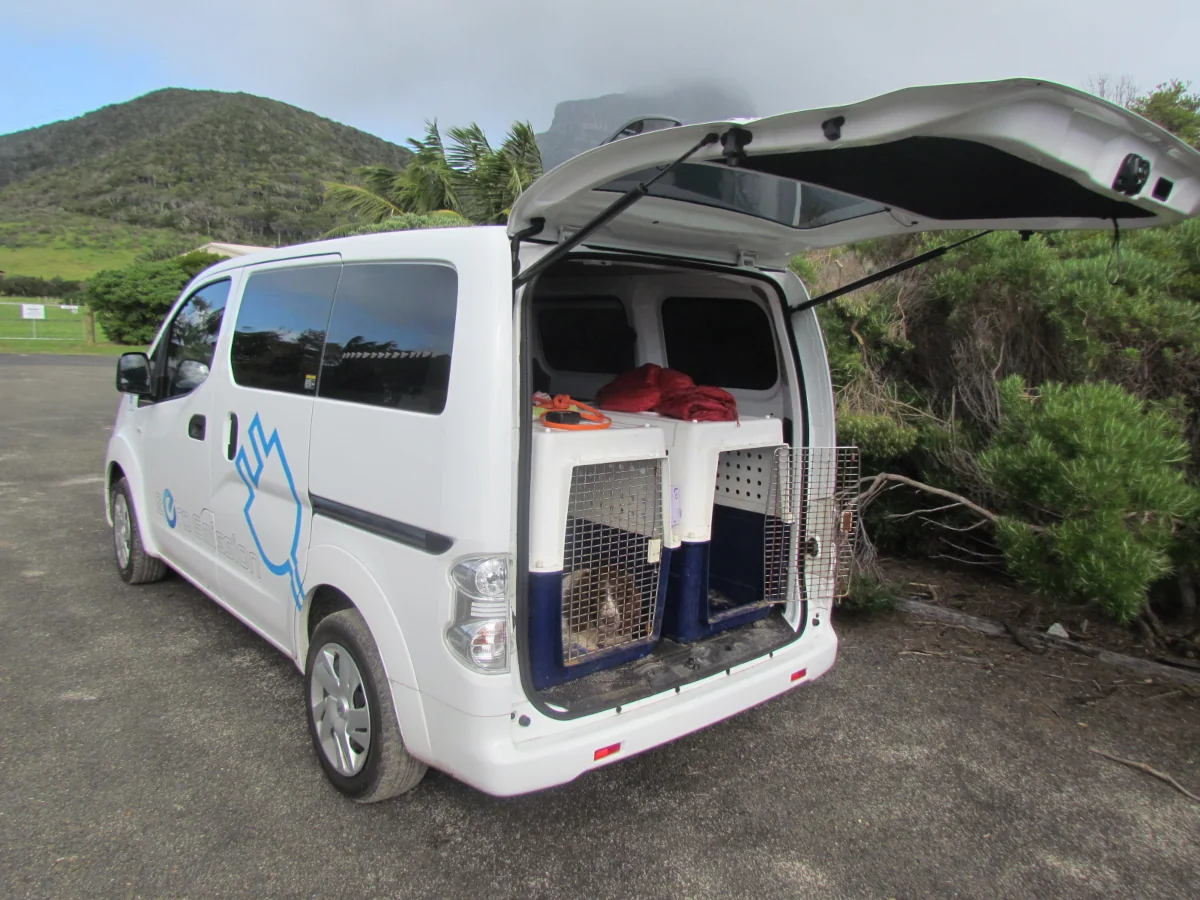
Talking with several EV owners on Lord Howe Island, environmental benefits are one of the main factors for their decision to go electric. For Lisa Makiiti and Rod Oxley, an EV was the obvious sustainable choice, “Along with island-wide environmental initiatives, we like the fact that we can contribute to Lord Howe’s sustainable energy future.”
Ian Hutton is researching the impact of climate change on Lord Howe Island and says he has “Always been keen to support moves to ameliorate Climate Change,” but also saw future resale as a benefit. “The future of vehicle transport is electric and I didn’t want to buy a dinosaur that may not resell.”
Reduced maintenance and running costs are also a big advantage of EVs on the island. Due to frequent short journeys and the stop/start nature of driving, internal combustion engines and exhaust systems cannot warm up properly, often causing costly problems much earlier than otherwise expected.
Charging at home is a necessity on the island, as there are no public charging stations available yet. A standard 10 A outlet is sufficient for keeping the vehicles topped up, of the people I spoke with, nobody saw the need to install a faster dedicated EV charger.
The cost and convenience of charging at home is another big advantage for the EV owners, especially compared to filling a fuel tank from the lone petrol bowser on the island that is only open for 1 hour a day, 6 days a week. Petrol is also currently around $4 per litre.
Bikes remain the preferred mode of island transport
One of the first things we did after landing on Lord Howe was to make our way to the local bike hire shop to pick up some two wheeled transport. Bikes and e-bikes are the preferred mode of transport on the island, as they make it quick and easy to get around with plenty of bike racks at restaurants, shops and waterfront attractions.
Tourists and residents alike are often seen riding around on bikes and even those residents with EVs still prioritise 2 wheels over 4. Ian Hutton says, “I try to use my e-bike as much as possible, so weekly use of the EV is minimal, but it is very handy in rain, at night and when I need to take rubbish to the tip, or carry heavy items around.”
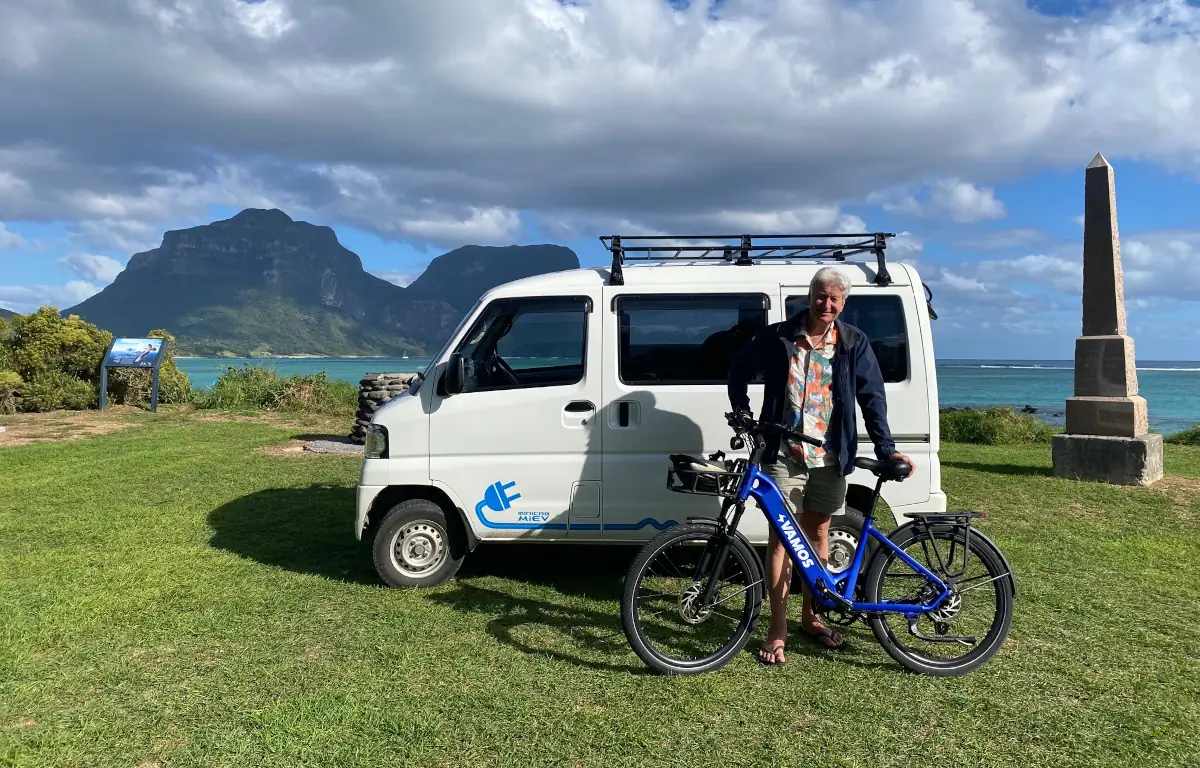
The path to 100% is not straightforward
The path to 100% renewables and electric transport on the island is not clear at this stage, despite the overwhelming success of the solar and battery system and clear preference for electric vehicles over internal combustion vehicles, at least among those lucky enough to already own one.
In terms of the power system, the Tesla batteries are often full by the middle of the afternoon and solar power is curtailed. Additional Tesla Powerpacks would be ideal to soak up this excess solar and increase the renewable energy penetration on the island, but unfortunately Tesla no longer makes Powerpacks and a Megapack would be overkill.
As for electric vehicles and home appliances, it is not straightforward for island residents to electrify everything. The Lord Howe Island Board tightly controls vehicles on the island and also restricts installation of electric appliances such as cooktops and hot water heaters to help maintain stability of the power system.
In terms of EV incentives, the board waives the wharfage fee for EVs which can potentially save around $300 on a newly imported vehicle. They remain expensive to import though, so they are generally run into the ground before they are replaced.
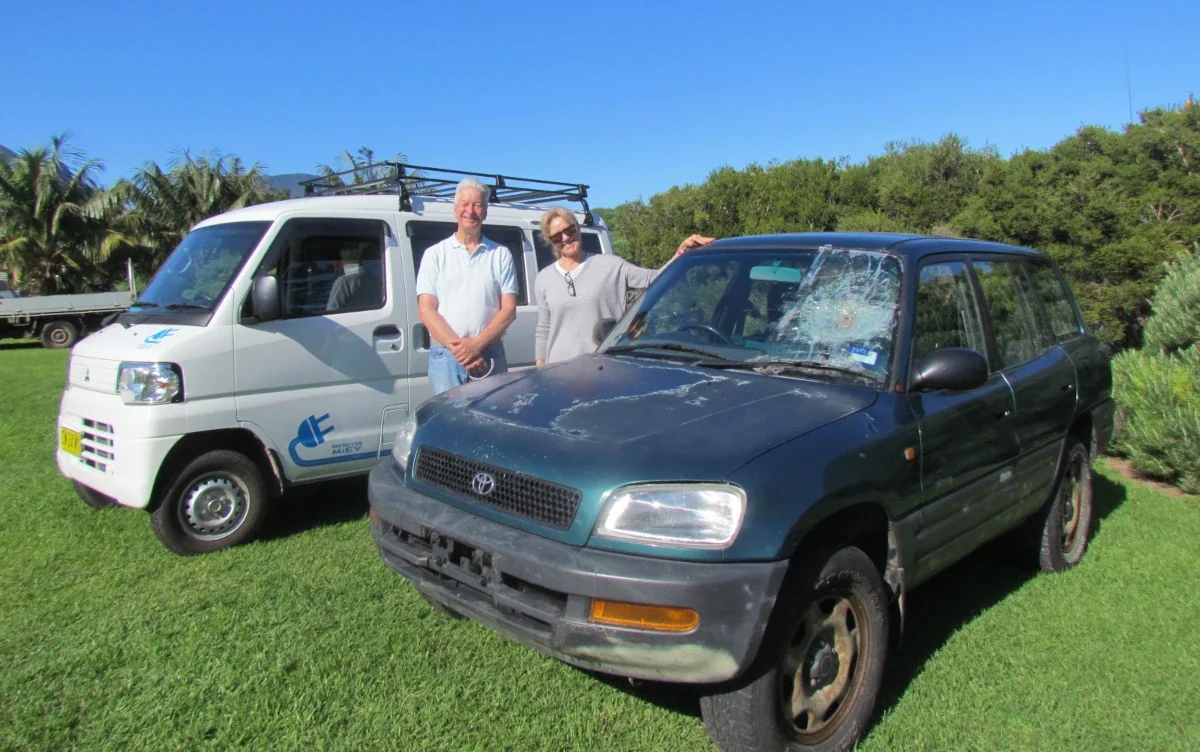
Once there are more affordable electric utes and people movers available in the near future, they would make ideal replacements for the diesel workhorses on the island, bolstering the small electric vans that have become common today.
Apart from being a fantastic holiday destination, Lord Howe Island provides glimpses into the future, where renewables dominate electricity generation and electric vehicle penetration is already approaching 10% of the fleet. I look forward to visiting again someday and seeing this progress continue.
Big thank you to Chris Murray for reviewing and fact checking the article, as well as Stuart Watson, Lisa Makiiti, Rod Oxley and Ian Hutton who all provided very helpful information that helped me understand the importance of electric vehicles on Lord Howe Island.

Tim has 20 years experience in the IT industry including 14 years as a network engineer and site reliability engineer at Google Australia. He is an EV and renewable energy enthusiast who is most passionate about helping people understand and adopt these technologies.

